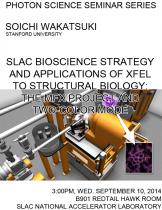Speaker: Soichi Wakatsuki, SLAC/Stanford University
Program Description
A strategy for developing an accelerator based integrative bioscience at SLAC will be presented. The key for further progress in biological research is the successful integration of different methods with multiple length- and time scales. The goal of the SLAC Bioscience strategy is to establish an accelerator based Bioscience Hub for structural biology research using protein crystallography, spectroscopy, small angle scattering and imaging at LCLS and SSRL, as well as new core expertise on CryoEM/UEM/UED and super-resolution light microscopy. In parallel, several science areas will be identified and developed as science spokes at the Hub focusing on environmental/bioenergy and biomedical science areas including a structure-based drug design platform.
The second part of this presentation will focus on the two new developments for macromolecular crystallography using XFEL beams: (1) two-color beam for de novo phasing and (2) a new LCLS station, the Macromolecular Femtosecond Crystallography (MFX). Results of the recent LCLS experiment using two-color doubly self-seeded pulses will be presented. The MFX station project has been launched in mid April with a two-year timeline and will be optimized for in-air data collection with a variety of sample delivery schemes. These projects are being pursued in collaboration with many groups locally and globally with a goal to provide integrated general user facilities as part of the SLAC Bioscience Strategy for cutting edge structural biology research.





